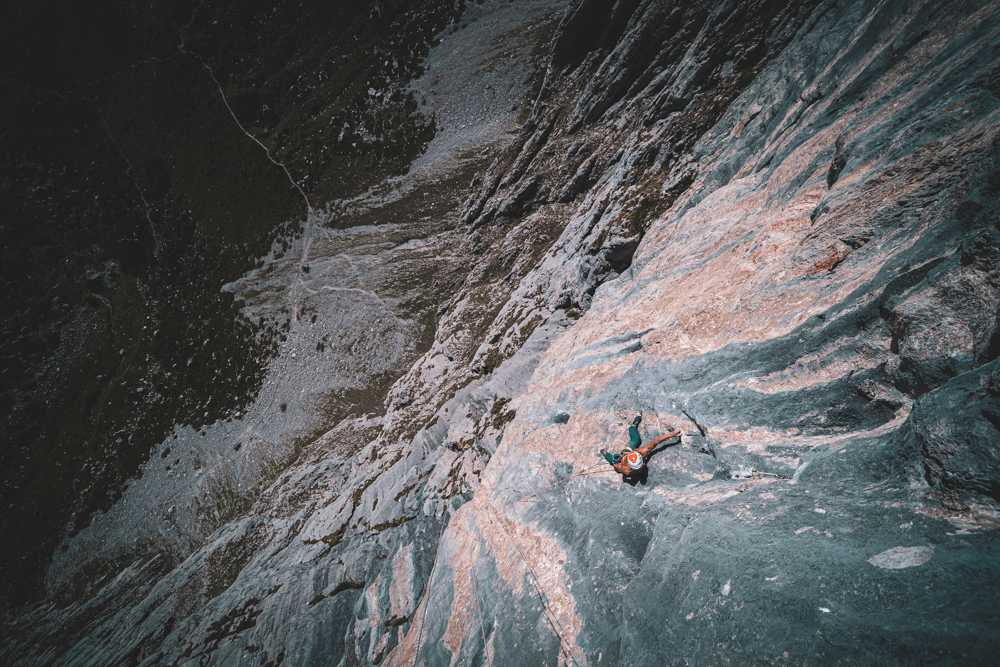Il l’a fait ! Louna Ladevant vient de s’offrir son projet automnal avec une rare répétition de la voie extrême du Rätikon en Suisse, “WoGü”. Connu pour ses podiums en compétition de cascade de glace, ses expéditions et réalisations en grande-voie difficiles, Louna franchit un nouveau pallier avec la 5ème ascension d’une des grandes-voies parmi les plus difficiles d’Europe : 350m, 8c max, ouverture en 1997 par Beat Kammerlander, 9 longueurs, cotations très sèches (6c, 6c+, 8c, 7c+, 8b+, 8b, 8b+, 8a+, 7c+). Louna en aura bavé ! 11 heures en paroi, 25 runs lors du push, un sommet à 22h avec les 3 dernières longueurs à la frontale, ce fut épique ! Louna revient là-dessus, interview exclusive !
– Qu’est-ce qui t’a motivé à essayer “WoGü” initialement ?
J’avais pas vraiment mis de projets dans mon niveau max en grande-voie, j’avais juste fait des trucs avec une journée ou 2 de travail, et ça marchait. Du coup je me suis dit que quitte à mettre de l’investissement dans une grande-voie, autant tenter l’extrême, probablement la voie ou une des voies les plus dures que je pouvais essayer en Europe sans aller trop loin non plus. Donc c’était l’idée. J’ai checké les cotations, tous les articles que je pouvais trouver dessus. Évidemment je me suis demandé au début si ce n’était pas trop ambitieux. Le fait qu’il n’y ait que des légendes qui l’aient réussie a aussi attisé ma curiosité : voir là où je me situais par rapport à ces grands noms de la grande-voie.
– Quand as-tu commencé à essayer la voie ? Combien de fois lui as-tu rendu visite ? Quelle a été ta stratégie pour progresser dedans ?
J’ai commencé à essayer la voie cet été, et ensuite je suis revenu 2 fois à l’automne bien qu’il fasse encore trop chaud pour la saison. Donc au final on a fait 3 trips et 7 jours de travail dans la voie. On a posé des stats et on a travaillé longueur par longueur. D’abord voir toutes les longueurs sans tout caler, juste pour estimer si c’était faisable. Vu que c’était ambitieux, je voulais m’assurer que tout soit faisable avant de peaufiner mouvement par mouvement. J’ai donc dégrossi puis je suis revenu sur chaque longueur pour les enchainer une par une, ou deux par deux. La longueur clé je l’avais déjà enchainé une fois, un peu à l’arrache. Je me suis dit que ça suffisait et que je n’avais pas le temps de caler davantage. Entre le créneau météo et les obligations que j’avais après, ça allait être compliqué si je tergiversais. Le Rätikon est complexe, quand les voies sont mouillées, ça peut mettre beaucoup de temps à sécher. C’est en altitude, il peut y avoir de la neige… J’avais la pression pour y aller relativement vite, c’est pour ça que j’ai décidé de faire un push après seulement 7 jours.
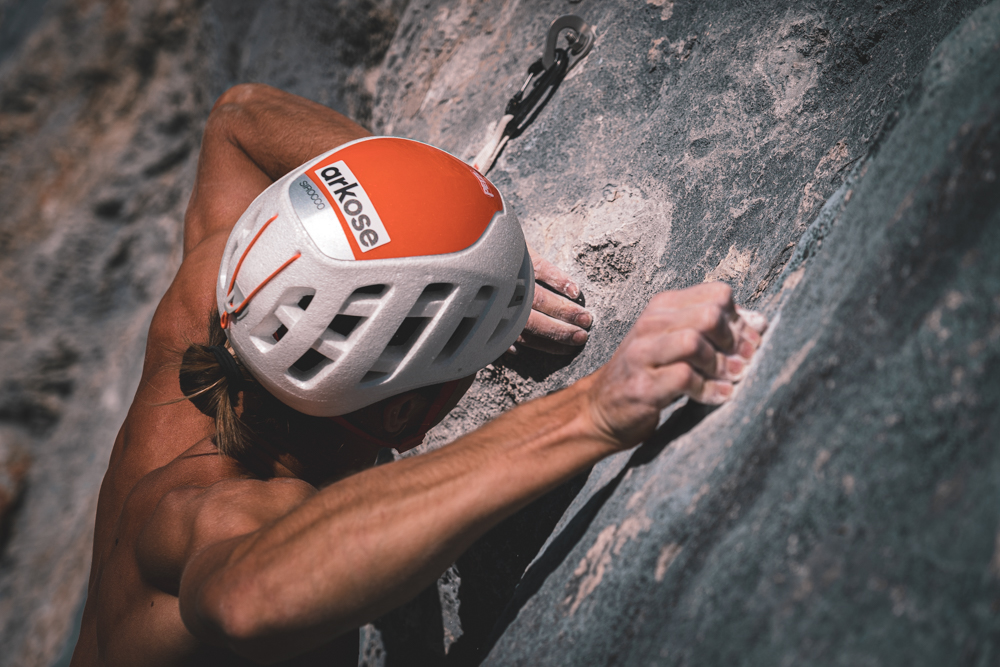
– Le style a l’air particulièrement exigeant et à doigts, peux-tu le décrire ? T’es tu entrainé spécifiquement ?
Le pire pour moi c’est le 8b+ en L5 qui est plutôt 8c, extrêmement dur à mon avis, qui fait même pas 10 mètres, vertical, voire dalle. Cette longueur, si tu enlèves une prise cela ne marche plus trop, ou alors ça devient un énorme cran au-dessus. Les pieds sont infâmes, tout plats, ou alors des grat’ de quelques millimètres. Il faut trouver ses méthodes pour progresser là-dedans. Cette longueur demande un effort monumental. Pour moi la longueur crux au final est moins dure. Cette L5 est la longueur la plus technique qui demande un investissement dans chaque mouvement. Il faut un investissement psychologique, technique et physique. Pour chaque déplacement de pied , il faut se forcer à respirer. Il y a 18 mouvements de main pour environ le double de pieds. C’est tout de même un peu long dans la difficulté et il faut arriver à pas craquer au milieu. Les autres longueurs sont plutôt typées bloc, un peu physiques en plus d’être à doigts, des grosses fermetures sur des petites prises. Il y a le crux du 8b qui est une cuvette avec une opposition en triceps dans un boite, et aussi la dernière longueur crux qui propose un 7C bloc en endurance de force sur des plats pas mal à conditions, de l’escalade assez classique avec des talons, des no foot, et puis tu repars pour 40m d’escalade dans un 8b ou 8a+ qui reste un peu technique.
– L’engagement de cette ligne est connu pour être sévère. Qu’en penses-tu ?
Oui, en effet, notamment les longueurs faciles, ou les parties faciles des longueurs dures. J’essayais vraiment de caler et dans l’enchainement j’ai essayé de grimper libéré, pas trop tendu pour m’économiser psychologiquement dans ces parties-là. Si tu es un peu trop crispé dans ces longueurs, le chute peut être problématique avec des plombs autour de 15 mètres à se mettre donc ça fait assez peur. Dans les longueurs dures, certaines chutes font mal, notamment pour l’assureur, on l’a vu d’ailleurs dans le film de Nina et Cédric, des chutes sous le relais, où l’assureur se fait placarder au mur. Tristan s’est fait mal au poignet comme ça. Pour toute la voie je crois qu’on n’a pas dû mettre plus de 60 dégaines, donc en moyenne 6 dégaines par longueur sachant qu’il y a des longueurs très longues. Cela donne une idée de la tonalité de la voie !
– Parle-nous des longueurs et des difficultés de la voie, qu’est ce que tu redoutais le plus et qui t’a posé le plus de problèmes ?
Certainement pour moi la première longueur en 8B+, L5 ! Cédric pensait pareil. La première longueur dure en 8c est assez classique, j’ai trouvé une nouvelle méthode dans le crux, tout droit, une méthode de grand. Pour moi c’est pas la plus dure sur le papier et tu es relativement frais quand tu la grimpes. C’était pas ce qui me faisait le plus peur comparé à cette longueur de dalle, et la dernière en haut car je savais que j’allais être fatigué.
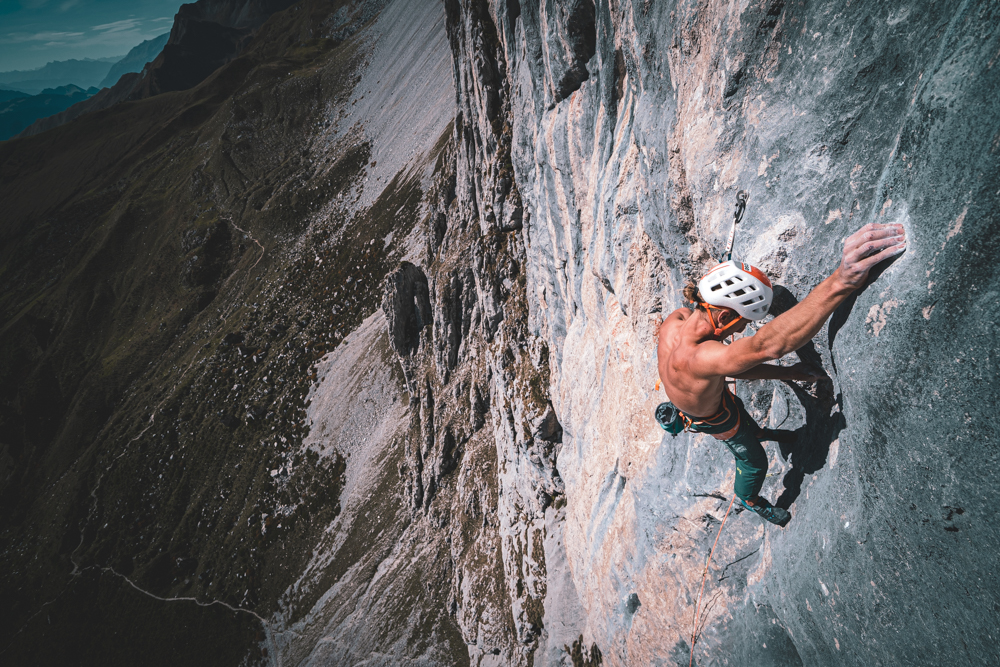
– Quand as-tu commencé à croire en tes chances ?
Uniquement quand j’ai réussi à passer la dernière longueur crux à la frontale car je pensais ne pas y arriver. C’était une journée plein de hauts et de bas et j’essayais d’avancer longueur après longueur sans me projeter, en me battant comme je pouvais. C’était pas évident du tout.
– Comment s’est passé le push ? Avec qui ?
C’était à la fois super bien mais parfois cauchemardesque, accompagné par mon frère Tristan qui m’assurait et de Damien Largeron chargé de faire les images même s’il nous aidait beaucoup avec le hissage des sacs aussi pour que ce soit plus pratique et efficace, afin que je puisse uniquement me concentrer sur la grimpe. Mais j’ai commis beaucoup d’erreurs, soit de ma faute, soit liées à la malchance. Par exemple j’ai zippé de la main tout en haut du premier 8c, faut dire que les condis étaient pas optimales non plus. J’ai réussi à le refaire mais il a fallu que je me refasse les 40 mètres. J’ai fait le 7c+ derrière et le 8b+ de dalle en 2 runs en me mettant le taquet de ma vie. Puis je suis tombé 3 fois dans le pas de bloc du 8b. Je pensais que cette longueur n’allait pas me poser de problèmes mais au final avec la fatigue c’était plus la même chose. Quelques erreurs, des pieds qui s’accrochent un peu bêtement et ça te fait tomber. C’est tellement exigeant et soutenu que le moindre truc qui ne marche pas comme il faut peut faire tomber. Après une chute il faut se remettre dedans, refaire un run et cela rallonge la journée de beaucoup même si la chute est pas très haut dans la longueur. Chaque fois c’est un coup de marteau derrière la tête. Après ce 8b tu arrives à la vire devant la dernière longueur très dure en 8b+/c. Je n’arrivais plus à faire le pas de bloc très physique du bas, complètement vidé. J’ai mis des runs comme je pouvais en me reposant au milieu, il a commencé à faire nuit et c’est passé vite. J’étais tellement fatigué après mes essais. Après 10/15 runs j’ai réussi à passer car Tristan m’a donné une idée de ré ré-essayer la position d’un talon qu’on avait pensé à faire mais que je n’avais pas calé car j’y arrivais bien autrement, sauf que là cuit ma méthode initiale ne marchait plus. Finalement grâce à ce talon, j’ai essayé quelques fois, c’était mieux et c’est passé.
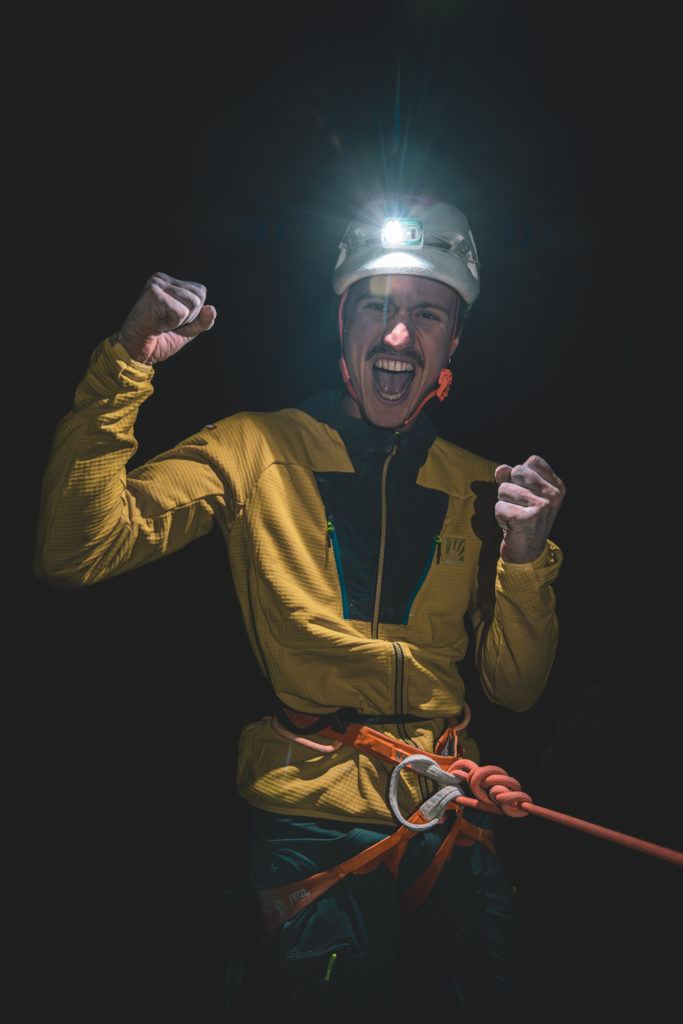
– Tu as terminé les 3 dernières longueurs, dont la longueur clé en 8b+ de nuit à la frontale ! Ce n’est pas commun, reviens là-dessus.
On ne voulait pas partir trop tôt le matin car on ne voulait pas être en paroi le moment où il n’y a pas d’air dans la voie. Le thermique se met en place vers 13/14h et j’ai lâché tellement de runs que je m’étais dit que si je terminais à la frontale c’était pas du tout grave. La nuit ne me faisait pas peur car j’étais assez calé. J’avoue que faire le crux du 8b+ à la frontale n’était pas évident. Les pieds sont petits, c’est dur de les voir. Souvent tu as la tête collée au caillou et c’est un peu compliqué avec les ombres. Mais franchement je n’étais plus à ça près, c’était coûte que coûte, la guerre, il n’y avait aucune raison valable pour arrêter. Les deux dernières longueurs de la voie se sont bien déroulées, elles sont un cran en-dessous même si ça reste des longueurs dans le 8. Ca s’est plutôt bien déroulé à part que j’avais des crampes sur le brachial sur l’insertion de l’avant-bras. Un truc qui m’arrive assez rarement, ce qui vous donne une idée de l’état de mon état de fatigue !
– Est-ce que d’autres challenges similaires aux Picos ou Dolomites sont dans ton viseur pour le futur ? Et le Yosemite ? Qu’est ce que tu aimerais accomplir en grande-voie à l’avenir ?
Pas trop d’idées en tête dans un future proche. Je pense plutôt m’entrainer pour cet hiver et faire une coupe du monde de glace, des projets en alpi hivernale avec Tristan et potentiellement une expé pour faire du big wall en attitude pour l’été prochain, et j’ai toujours “Le Cadre” en chantier à Céüse.
Je rajouterais un petit mot pour la fin en disant que c’était assez particulier les émotions qui m’ont traversées cette journée, c’était très dur, j’avais pas mal de pression avant de partir avec peu de possibilités pour essayer la voie. Tristan et Damien étaient derrière moi donc j’avais envie de réussir aussi pour valoriser leur investissement. A chaque erreur, cela faisait que ça devenait de plus en plus dur mais j’y arrivais assez vite après ; il y a eu pas mal de moments difficiles dans la journée, ça a été assez long et j’avais jamais encore vécu d’expérience de la sorte. Quand j’ai passé le dernier crux qui m’a posé tant de problèmes, j’avais presque envie de pleurer au repos d’après, mais je ne pouvais pas car 40 mètres d’escalade m’attendaient avec 2 pas de bloc. Je ne devais plus tomber, et ultra concentré et guerrier, ce n’était pas le moment de laisser mes émotions s’emparer du truc, du coup en haut ça n’a pas été l’explosion de joie tellement j’avais canalisé mes émotions. C’était magique mais il y a eu l’ensemble de la journée qui a fait que ça a été assez dur. Une journée à 25 runs environ… Moi qui croyais ne pas avoir de volume !
Photos : Damien Largeron
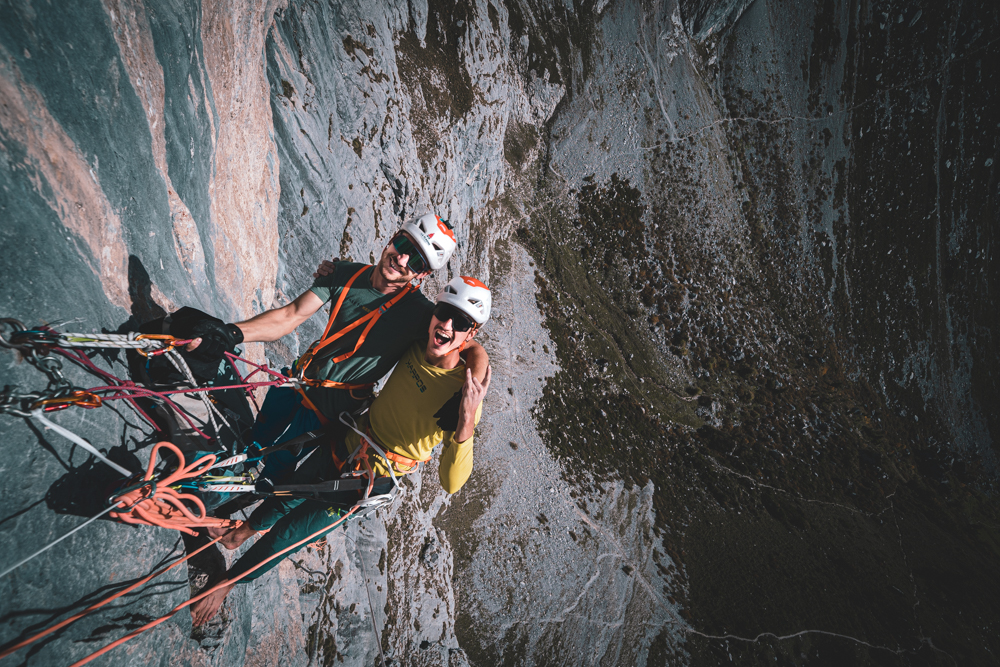
He climbed it! Louna Ladevant just completed his autumn project with a rare repeat of extreme Rätikon route in Switzerland, “WoGü”. Well-known for his podiums in ice climbing competitions, his expeditions and achievements on difficult multi pitches, Louna reached a new milestone with the 5th ascent of one of Europe’s most difficult long routes: 350m, 8c max, opened in 1997 by Beat Kammerlander, 9 pitches, very sharp grading (6c, 6c+, 8c, 7c+, 8b+, 8b, 8b+, 8a+, 7c+). Louna will have had it rough! 11 hours on the wall, 25 goes during the push, a summit at 10pm with the last 3 pitches by headlamp – it was epic! Exclusive interview!
– Which things motivated you to try “WoGü” in first place?
I hadn’t really put any projects into my max level on multi pitch, I’d just done stuff with a day or 2 of work, and it worked. So I thought that if I was going to invest in a MP, I might as well try something extreme, probably the hardest route or one of the hardest routes I could try in Europe without going too far either. So that was the idea. I checked out the infos and all the articles I could find on the subject. Of course, at first I wondered whether it was too ambitious. The fact that there were only legends who looked successful also drew my curiosity: to see where I could joint these great names of multi pitch climbing.
– When did you start trying out the route? How many times have you visited it? What was your strategy for making progress on it?
I started trying the route this summer, and then I came back twice in the autumn, even though it was still too hot for the season. So in the end we did 3 trips and 7 days of work on the route. We put static ropes down and worked it pitch by pitch. First, we scoped all the pitches without setting everything, just to estimate whether it was doable. As it was an ambitious project, I wanted to make sure everything was doable before finding more precise betas move by move. So I worked out the kinks, then went back over each pitch to send them one by one, or two by two. The key pitch I’d already done once, a bit on the fly. I told myself that was enough and that I didn’t have time to work further. Between the weather window and the obligations I had afterwards, it was going to be complicated if I procrastinated. The Rätikon is complex, and when the routes are wet, it can take a long time to dry. It’s an altitude wall, there could be snow… I was under pressure to go relatively quickly, which is why I decided to make a push after only 7 days.
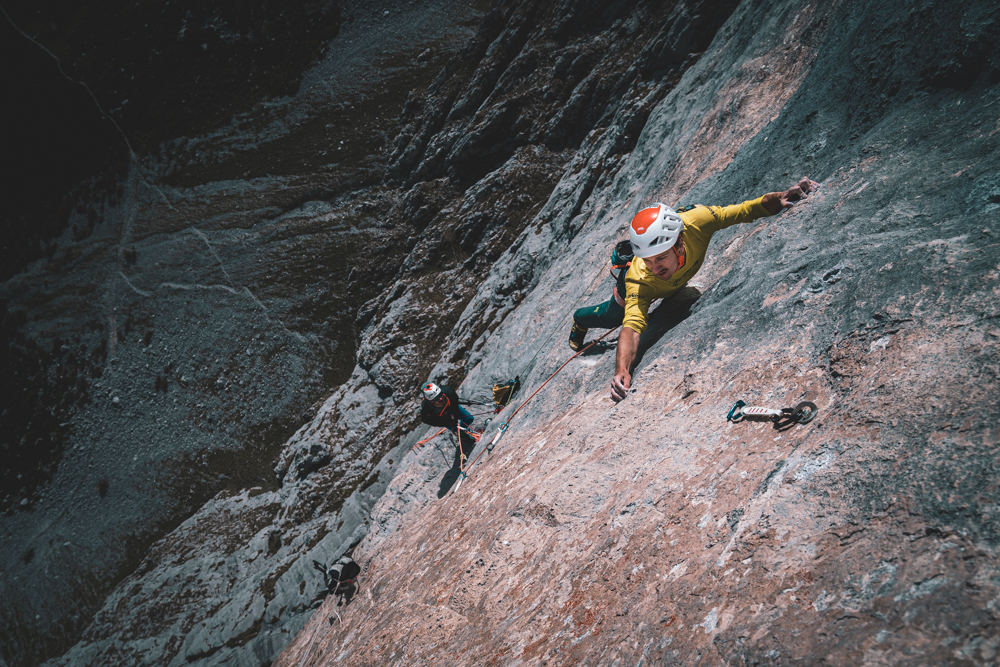
– The style looks particularly demanding and fingery, can you describe it? Have you trained specifically?
The worst for me is the 8b+ in L5, which is more like 8c, extremely hard in my opinion, not even 10 meters long, vertical, even slab. This pitch, if you take a hold off it doesn’t really work anymore, or it becomes a huge step above. The feet are infamous, all flat, or a few millimetres long, like razors. You have to find your own betas to progress in this area. This pitch requires a monumental effort. For me, the crux pitch in the end is easier. L5 is the most technical pitch, requiring investment in every move. You need to invest psychologically, technically and physically. For each foot move, you have to force yourself to breathe. There are 18 hand moves for about twice as many feet moves. It’s still a little long in terms of difficulty, and you have to manage not to fail in the middle. The other pitches are more boulder-like, a bit physical as well as being finger-holding, with big deadpoint moves on small holds. There’s the crux of the 8b, which is a big slopy hole with triceps opposition in a box, and also the last crux pitch, which offers around 7C bouldering with strength endurance on slopers, fairly classic climbing with heelhooks, no foot moves, and then you’re off again for 40m of climbing in an 8b or 8a+ that remains a little technical.
– The run-outs of this line are known to be severe. What do you think?
Yes, indeed, especially the easy pitches, or the easy parts of the hard pitches. I was really trying to relax on these parts and to climb free-minded, not too tense to save myself psychologically. If you’re a bit too tense in these pitches, the fall can be problematic, with whippers around 15 metres long, so it’s pretty scary. In the hard pitches, some falls can hurt, especially for the belayer, as we saw in the Nina et Cédric’s film, falls under the belay, where the belayer is pinned to the wall. Tristan hurt his wrist like that. For the whole route, I don’t think we used more than 60 quickdraws, so on average 6 per pitch, bearing in mind that there are some very long pitches. That gives you an idea of the character of the route!
– Tell us about the pitches and difficulties of the route, where did you struggle the most and which things caused you the most problems?
Definitely for me the first pitch in 8b+, L5! Cédric thought the same. The first hard pitch in 8c is pretty classic, but I found a new method in the crux, straight up, a great method. For me, it’s not the hardest on paper and you’re relatively fresh when you climb it. It wasn’t what scared me the most compared to this pitch of slab, and the last one at the top because I knew I was going to be tired.
– When did you start believing in your chances?
When I climb the crux of the last key pitch with headlamp. It was a day full of ups and downs, and I tried to keep going pitch by pitch without projecting, fighting as best I could. It wasn’t easy at all.
– How was the push? Who was joining?
It was both great and at times nightmarish, with Tristan looking after me and Damien Largeron in charge of the images, although he also helped us a lot with the hoisting of the bags to make it more practical and efficient, so that I could focus on the climbing. But I made a lot of mistakes, either of my own making or due to bad luck. For example, I slipped with my hand at the very top of the first 8c, although the conditions weren’t ideal either. I managed to do it again, but I had to do the 40 meters again. I did the 7c+ behind and the 8b+ on the slab in 2 goes, the fight of my life. Then I fell 3 times on the boulder crux of the 8b. I thought this pitch wasn’t going to give me any problems, but in the end, with fatigue, it was an other affair. A few mistakes, a few feet hanging on a bit foolishly, and you fall. It’s so demanding and sustained that the slightest thing that doesn’t work as it should can make you fall. After a fall, you have to get back into the swing of things and do another go, which makes the day much longer, even if the fall is at the beginning of the pitch. Every time it’s a hammer blow to the back of the head. After this 8b, you reach the ledge in front of the last, very hard 8b+/c pitch. I couldn’t do the very physical crux at the bottom, completely exhausted. I put the goes as best I could, resting in the middle, then it started to get quickly dark. I was so tired after my goes… After 10/15 goes, I managed to get through because Tristan gave me the idea of re-trying a heelhook beta that we’d been thinking of doing but that I hadn’t try so much because I was doing my initial beta, which suited me well fresh but didn’t work any more tired. Finally, thanks to this heelhook, I tried it a few times, it was better and it worked.
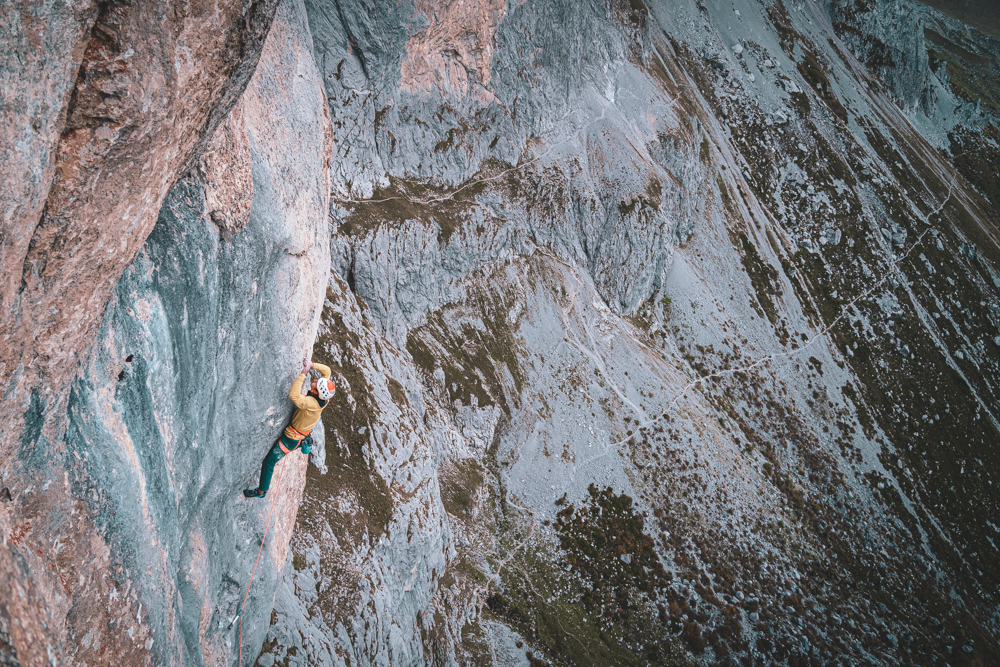
– You finished the last 3 pitches, including the key 8b+ pitch at night with a headlamp! That’s unusual, what about this experience?
We didn’t want to leave too early in the morning because we didn’t want to be on the wall when there was no air in the route. The thermic wind set in around 1pm/2pm and I dropped so many goes that I told myself that if I finished with a headlamp, it wouldn’t be a problem at all. I wasn’t afraid of the night because I was pretty well prepared. I must admit that doing the crux of the 8b+ with a headlamp wasn’t easy. The feet are small and it’s hard to see them. Your head often sticks to the rock and it’s a bit tricky with the shadows. But to be honest, I’d come this far, it was whatever it took, like a war, there was no good reason to stop. The last two pitches of the route went well, they’re a step down even if they’re still pitches in the 8th grade. It went pretty well, apart from the fact that I had cramps on the arm, on the forearm insertion. Something that rarely happens to me, which gives you an idea of how tired I was!
– Are other challenges similar like in the Picos or Dolomites in your sights for the future? What about Yosemite? What would you like to achieve on the MP game in the future?
Not too many ideas in mind for the near future. I’m thinking more of training for this winter and doing an ice world cup, winter alpine projects with Tristan and potentially a big wall expedition in attitude for next summer, and I’ve still got “Le Cadre” at Céüse as long time project.
I’d like to add a final word by saying that the emotions that ran through me that day were quite special. It was very hard, and I was under quite a lot of pressure before setting off, with very few opportunities to try the route. Tristan and Damien were right behind me, so I wanted to succeed too, to thank them for their support. Every time I made a mistake, it got harder and harder, but I arrived to make progress pretty quickly afterwards, so there were quite a few difficult moments during the day, it was quite long and I’d never experienced anything like it before. When I passed the last crux that gave me so many problems, I almost wanted to cry at the rest after, but I couldn’ because 40 meters of climbing awaited me with 2 bouldering cruxs. I couldn’t let my emotions get the better of me, so at the top I didn’t burst with joy because I’d channelled my emotionsa all long. It was magical, but the whole day made it pretty tough. A day of about 25 goes… And I thought I had no volume!
Pics: Damien Largeron
